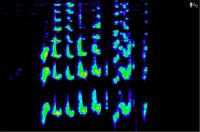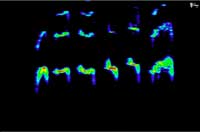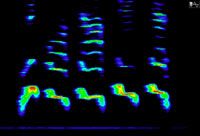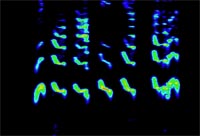Case 1 (2003) 43 yo
|
This surgery removes the anterior portion of the voice box (thyroid cartilage) and shortens the vocal cords before putting the voice box back together. These recordings are set to a fairly low resolution for the internet but do demonstrate the general sound and function of the vocal cords before and after a single case of laryngeal reduction surgery. Much more detail is actually visible in the office. The videos when shown are oriented with the front down and the left vocal fold is on the right of the video. Orientation is discussed here. Please note: These examples of possible results and for this case actually required two revisions to reach this point. There are many components to a voice exam. I have selected ones here that I feel change the most with this type of surgery. Below are the patient’s comments on the surgery. |
|
|
Pre Surgery |
6 weeks |
4 months |
2 years |
|||||||||||||||||||||||||||||||||||||||||||||||||||||||||||||||||||||||||||||
Reading passagePitch is described relative to C4 or middle C on the piano. |
|||||||||||||||||||||||||||||||||||||||||||||||||||||||||||||||||||||||||||||||||
|
Pitch: about A2 (typical male speaking range about B2 - E3) |
Pitch: about A3 (normal female speaking range about E3 - A3) more airiness |
Pitch: about C4# (normal female speaking range about E3 - A3) |
Pitch: about G3#/A3 (normal female speaking range about E3 - A3) |
||||||||||||||||||||||||||||||||||||||||||||||||||||||||||||||||||||||||||||||
Lowest pitch |
|||||||||||||||||||||||||||||||||||||||||||||||||||||||||||||||||||||||||||||||||
|
Pitch: about A2 (normal male low range varies C1 - C3) |
Pitch: about D3 (normal female low range varies between B2 - F3) with more air leak, and very low volume |
Pitch: about D3 |
Pitch: about E3 |
||||||||||||||||||||||||||||||||||||||||||||||||||||||||||||||||||||||||||||||
Highest pitch |
|||||||||||||||||||||||||||||||||||||||||||||||||||||||||||||||||||||||||||||||||
|
Pitch: about B4 |
Pitch: about B4 |
Pitch: F5# |
Pitch: F5# |
||||||||||||||||||||||||||||||||||||||||||||||||||||||||||||||||||||||||||||||
Vegetative soundscoughing & throat clearing |
|||||||||||||||||||||||||||||||||||||||||||||||||||||||||||||||||||||||||||||||||
|
Pitch: |
Pitch: similar |
Pitch: similar |
Pitch: similar |
||||||||||||||||||||||||||||||||||||||||||||||||||||||||||||||||||||||||||||||
Yellloud phonation |
|||||||||||||||||||||||||||||||||||||||||||||||||||||||||||||||||||||||||||||||||
|
|
quite a bit higher |
||||||||||||||||||||||||||||||||||||||||||||||||||||||||||||||||||||||||||||||||
Rigid stroboscopysaying the sound /i/ |
|||||||||||||||||||||||||||||||||||||||||||||||||||||||||||||||||||||||||||||||||
SpectrogramStarting on the right is speech, moving left are vowels |
 |
 |
 |
 |
|||||||||||||||||||||||||||||||||||||||||||||||||||||||||||||||||||||||||||||
| The surgeon’s comments: |
The vocal cords are certainly shorter after the surgery. This is a new procedure and we eventually revised this surgery twice to improve the inital less than optimum results. I attempted the initial surgery under local anesthesia, but felt I could not pull the vocal cords tight enough during the local anesthesia and risked tearing the sutures out. The cords were also not shortened enough. With the second revision under general anesthesia and the ability to get additional vocal cord tightening and thyroid cartilage removal, the voice improved in both pitch and volume. Six weeks post surgery, this is still an early result. The immediate, airy voice has strengthened quite a bit over the six weeks, but still is fairly breathy. While the comfortable speaking pitch is higher, there is a resonance mismatch between the pharynx (throat) and the vocal pitch. There may even be a tension mismatch between the cords. This is perhaps most evident in the post-video where the voice resonantes louder as the throat squeezes in. Overall, I would say laryngeal reduction has both plusses and minuses when compared to a cricothyroid approximation. It is more involved and has a greater risk to the voice quality. It perhaps has some potential, especially in some patients as the cricothyroid approximation does not produce durable results in all patients. 16 weeks post surgery, I think the result is heading in the right direction. Though not in the standard recordings above, there are times when I am listening to the patient in a relaxed voice and she drops down to a speaking pitch of A3 (a high normal female pitch) and there is a bit of chest register kicking in as opposed to the above recording, which I would liken more to a falsetto sound. It will be interesting to see what time brings. |
Long term the results seem to be holding up or are perhaps even more smooth in terms of the sound. |
|||||||||||||||||||||||||||||||||||||||||||||||||||||||||||||||||||||||||||||||
| The patient’s comments: |
A Review of Feminization Laryngoplasty with James P. Thomas, MDPrepared October 17, 2003 IntroductionThis is a critique of the people, processes, facilities, procedures and results of my Feminization Laryngoplasty surgery and subsequent revisions from March 2003 to present. This is not meant to be personally critical, but to provide an honest review from an informed patient’s perspective. It is hoped that this will be used by all concerned as a basis of examination and corrective actions resulting in continual improvement. While not commonly used in the medical field, this process is derived from ISO9000 quality standards and has proven very effective in many diverse industries. Its application to medical processes seems reasonable. The review is segregated into specific activities and processes with each discussion pointing out positives, negatives and citing needed corrective actions. A summary grade from A to F is made for each section. I identified James P. Thomas, MD as a surgeon of interest from his web presence. The website was very comprehensive and appeared to be designed as an information source rather than an advertisement. This gave a very positive first impression. My initial email was responded to within three days; however, my follow up email was not answered for over two weeks. This delayed response caused me to move Dr. Thomas to the “not-interested” list. Subsequent email responses have been very quick.
Initial Consultations (Email and Telephone)My initial discussions with Dr. Thomas about the proposed procedure were thorough and complete. He advised me of the procedure details and possible risks. Additionally, he stressed that as an experimental procedure, the probability of a positive result was unknown and the possibility of revision procedures was high. I was impressed with his honesty.
Front OfficeAfter deciding to go forward with the surgery, I contacted Jody, RN to schedule an office visit and subsequent surgery. She readily accommodated my expedited schedule requests and efficiently handled all the required paperwork and financial transactions. In addition, she was helpful in providing travel and hotel information. I found the front office to be extremely responsive on all issues.
Financial ConsiderationsSince this type of procedure is typically not covered by health insurance, the fees are of paramount interest to most patients. I was quoted the same fee as a standard CTA procedure. This seemed very fair and reasonable at the outset. Having gone through the initial procedure and subsequent revisions, I feel that Dr. Thomas has been more than fair with his fees. I have spent more on travel expenses than I have on his fees. The nature of a first case experimental procedure precludes excess profit, but I feel bad that he has most assuredly incurred a loss on my case.
Office ExaminationThe office is clean and modern in a well maintained building. The natural wood cabinets, furnishings, art and lighting present a pleasing contemporary atmosphere. Jody was thorough, professional and friendly as we completed the required paperwork. The examination room appeared well thought out. The full wall display of various diplomas, awards, etc was possibly overdone. Physical layout was efficient, providing convenient access to the required equipment. All the equipment seemed modern and well maintained. The wall mounted monitor that allows the patient to view the procedure is noteworthy. The battery of vocal tests and visual inspection of the vocal folds is thorough and impressive. The recording and indexing of the collected data was excellent. Dr. Thomas clearly explained the proposed procedure with the possible risks and I signed the necessary surgical consent paperwork. Dr. Thomas and Jody meticulously explained pre and post surgical instructions to me. Jody was helpful in providing basic Portland tourist information, restaurant recommendations and navigational instructions. Subsequent office examinations have continued the same high standard of quality.
Voice TherapistMy session with the voice therapist was much less impressive. Although friendly, she appeared to have no particular agenda or goals. After a quick review of my voice and history, she gave me a few basic tips on voice feminization. The remaining 50% of the session was spent discussing merits of various Opera singers. I received no benefit from this session. Its value as a patient eligibility screening test is also in doubt.
Surgical CenterThe co-location of the surgical center is very convenient. It appeared to be clean and well staffed. The surgical personnel were friendly and attentive. They seemed to be truly concerned about the well being of the patient. I find this atmosphere preferable to a conventional hospital. On two of my three visits, the receptionist seemed uninformed, disinterested and preoccupied with other activities rather than the waiting patient. Also, when I arrived at the designated report time for two of my surgeries, I found the elevator to the surgery center disabled. I had to wait in the downstairs atrium for thirty minutes until the elevator was turned on.
The ProcedureThis laryngeal reduction procedure turned out to be more complex and perilous than originally anticipated. Good results are dependant upon minute surgical details. Proper alignment of the vocal folds in all three axes must be accomplished to within a few hundred microns. Symmetric tension must be maintained on both folds. The pitch is dependant upon the resultant vocal fold length and vocal fold tension. The required amount of tissue resection is extreme Ð almost 50% of the effective vocal fold. Now that I better understand these factors, I am amazed that the techniques used have resulted in as good a result as I am now experiencing. This can only be attributed to the premier surgical skills of Dr. Thomas. These precision requirements make the probability of required subsequent revision procedures very high and even with a successful procedure, there are resonant mismatch issues. Without a significant investment in technology to assist in the procedure, I see it as a high risk endeavor. Suggestion: To be an optimally successful one pass procedure, additional technical aids would be required: Initial imagery to determine dimensions, custom designed tensiometer to measure vocal fold tension, optical magnification of the surgical site, real-time use of videolaryngoscopy and spectral analysis. If the investment were made to provide this technology, I feel this procedure would be much more viable at an acceptable risk.
The ResultsThe resultant voice is over an octave higher in pitch, although with a noticeable lack of resonance and slight airiness. At normal amplitudes, it is clear, intelligible and of good quality. At louder amplitudes, the voice quality is diminished, sounding weak and losing clarity. The maximum useable amplitude is significantly reduced from pre-surgery levels. Basic Measurements: (‘e’ sound at normal amplitude)
An analysis of the measurements shows that the post surgery pitch is in the upper female range with good SNR, jitter, shimmer and phonation time. This would indicate a very successful procedure with minimal vocal fold misalignment and good voice quality. After several months of healing, the harmonic coefficients (the level of each harmonic with respect to the fundamental) have improved to near pre-surgery levels, although a lack of resonance is evident in the voice. Basic Measurements: (‘e’ sound at loud amplitude)
These measurements show the increase in pitch, quality reduction and low harmonic coefficients at higher amplitudes. The voice at moderately loud levels is intelligible, but with obvious quality issues. Very loud phonation is not possible. The resonant mismatch and amplitude issues appear to be fundamental flaws in this approach to voice pitch elevation. In summary, the reduction laryngoplasty with subsequent revisions has been successful. My voice is over an octave higher in pitch and of good quality. Despite the technical challenges of this procedure, my overall experience and satisfaction level are positive. Given my current knowledge, would I repeat the process? Yes; although I would like to see technical surgical aids utilized to reduce the probability of required revisions. Would I recommend it to others? Yes; but with significant caveats: the risk to voice quality is very high and revision procedures will likely be required in order to achieve a good result.
James P. Thomas, MDOver the years, I have been involved with a large number of medical professionals in varying disciplines. Many have not met my expectations; Dr. Thomas has far exceeded them. In my business environment, I am accustomed to dealing with intelligent professionals and have very high expectations for their performance. My expectations for a medical professional are no less. The motivation of a scientist is to discover new things and apply that knowledge to solve problems that improve the human condition. I believe that a physician should have the same motivation with an added element of compassion. Dr. Thomas exemplifies these attributes. Before I initially contacted Dr. Thomas, I was impressed by the data and presentation of his web site. He appeared to be someone who desired to seek knowledge, share discoveries and advance medical science. He seemed to understand the importance of community knowledge and consultation among peers. My experiences as his patient have shown this initial assessment to be accurate. While his exemplary medical knowledge and surgical skills are without question, I am more impressed by his openness to new concepts, willingness to advance the state of the art and positively contribute to the medical community. I feel that Dr. Thomas is an extraordinary individual and consummate medical professional.
Jody, RNJody has demonstrated meticulous proficiency, professionalism and efficiency in all my dealings with her. She continually exceeded my expectations and always provided services beyond the requirements of her position. Acting as nurse, receptionist, administrator, cashier, schedule coordinator, travel agent and concierge, she transformed the customary medical administrative tedium into a pleasant visit with a friend. I found her emotional support throughout this process invaluable. She is truly a premium asset to Dr. Thomas’ organization.
SummaryIn summary, the reduction laryngoplasty with subsequent revisions has been successful. My voice is over an octave higher in pitch and of good quality. Despite the technical challenges of this procedure, my overall experience and satisfaction level are very positive. I have found Dr. Thomas and his staff exceptional people to work with. Given my current knowledge, would I repeat the process? Yes; although I would like to see technical surgical aids utilized to reduce the probability of required revisions. Would I recommend it to others? Yes; but with significant caveats: the risk to voice quality is high, revision procedures will likely be required in order to achieve a good result and a healing time of several months should be anticipated. I am a satisfied patient. A comparison of my before and after voices is amazing. Although there are minor remaining quality issues with my voice, I find if far superior to its pre-surgery condition. I am forever indebted to Dr. Thomas and his staff for their efforts. |
||||||||||||||||||||||||||||||||||||||||||||||||||||||||||||||||||||||||||||||||
